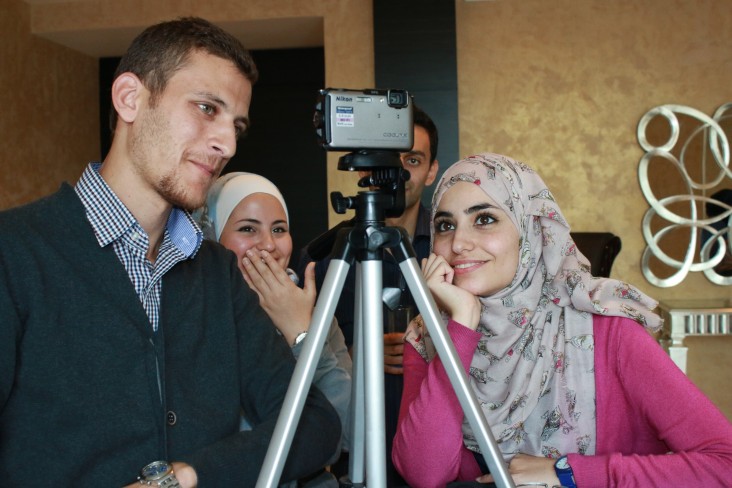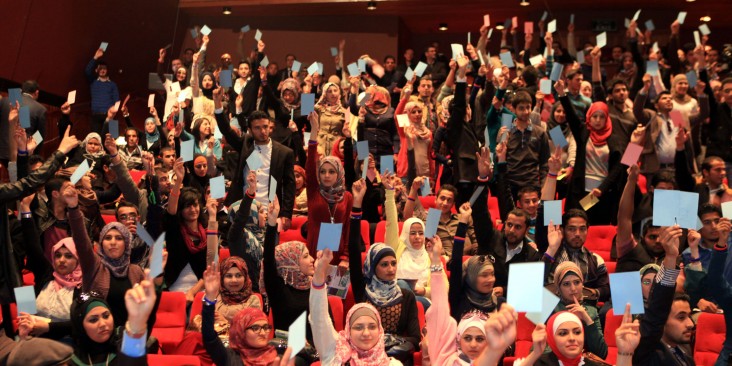OVERVIEW
Young people make up the largest proportion of Jordan’s fast growing population, presenting both possibilities and challenges for the future. If Jordan makes significant strategic investments in human capital, job creation and other necessary policies, it could collect a “demographic dividend” over the next four decades. This could double the working population. However, if the situation remains unaddressed, high unemployment and deep pockets of poverty and disenfranchisement will persist.

Having youth participate positively in all aspects of life is a high priority for the Government of Jordan. Jordan was the first Arab country to develop a National Youth Strategy (2005-2009) in consultation with 50,000 youth. In addition, existing sector-specific programs will fund intensified efforts to engage Jordanian youth and to provide them with better social, educational and employment opportunities. They will focus on helping the most vulnerable youth succeed. These are youth that come from disadvantaged urban areas, communities hosting refugee populations and areas prone to conflict and extremism.
CHALLENGES
Future prospects for youth are challenged by limited natural resources, rapid population growth, regional instability, an education system struggling to meet 21st century needs, limited policy engagement, increasing cost-of-living and slow economic growth that does not create sufficient jobs for the expanding workforce. More than half of working-age youth are unemployed, representing a major part of Jordan’s growing number of urban poor.

Despite government and donor efforts, very few policies and programs have addressed the needs of the most vulnerable at-risk youth. Their situation is worsening, compounded by several socio-economic factors. Youth face complicated challenges, in which traditional expectations and fast-changing realities collide.
There are few safe outlets for social or recreational activities. Young girls are especially restricted when it comes to having the mobility and opportunity to develop their talents. Youth need more professional, youth-sensitive social services. They need more opportunities for political participation and civic engagement.
MORE YOUTH FACTS
Youth Sector ![]() (pdf - 344k)
(pdf - 344k)
- Jordanian population under the age of 30: more than 70%
- Jordanian population under the age of 15: 36%
- Age 15-19 unemployment rate (third quarter 2015): 22.9%
- Age 20-24 unemployment rate (third quarter 2015): 31.5%
- Females holding two-year degree or higher among unemployed: 78%
- Jordanian population living/working in cities: 83%
- Newly eligible voters (age 18) in 2014: 370,000
- Priorities identified by at-risk youth in the 2014 USAID National Youth Assessment:
- quality of education, employability, civic and community engagement
CURRENT PROGRAMS
USAID cooperates with the Ministry of Social Development, the Ministry of Education, the Higher Council for Youth, and many other national agencies and civil society organizations to focus on:
Enhancing Skills and Employment Opportunities:
- supporting improved relevance and quality of formal public education;
 Audience members hold up cards to vote for the Ana Usharek debate competition.
Audience members hold up cards to vote for the Ana Usharek debate competition. - preventing youth from dropping out of school and expanding and enhancing non-formal education for youth who have dropped out;
- developing youth work readiness based leon market demands, entrepreneurship and job-seeking skills;
- strengthen job placement programs and counseling services;
- linking students/youth with mentoring, internship and job opportunities in the private sector;
- promoting healthy lifestyles and life planning, including family planning;
- engaging youth in development and social issues such as human rights, health, water and energy; and
- providing positive youth opportunities such as volunteering and participating in community development and civic affairs.
Improving the Infrastructure and Environment for Youth:
-
building/renovating schools, recreational facilities and other public spaces;
-
providing accessible, youth-friendly services in communities;
-
supporting policy coordination and capacity-building among institutions serving youth; and
-
engaging the private sector and community institutions in youth programs.
IMPACT & RECENT ACHIEVEMENTS
-
Revamped tourism and hospitality vocational training and university programs to include internships at hotels across Jordan, thus better preparing youth for entering the workforce
-
Helped the Jordan Applied University College of Hospitality and Tourism attain the UN World Tourism Organization International Certification and upgraded vocational training centers in Ajloun, Tafileh and Irbid for hospitality and bakery programs
-
Provided 22 scholarships at the Madaba Institute for Mosaic Art and Restoration (MIMAR)
-
Trained 439 youth in business skills and gave 41% of trainees loans, which totaled $125,670 in 2014
-
Upgraded career guidance offices and introduced entrepreneurship programs at Jordanian universities, and developed entrepreneurship content for the National Entrepreneurship and Employment Portal.
-
Supported media campaigns and community service organization initiatives to increase youth participation in the electoral process as election observers, candidates and voters
-
Trained nearly 500 law students on human rights and judicial skills through presentations and visits to organizations vital to the justice system such as correctional facilities, the department of forensic medicine, and the crime lab
-
Engaged more than 14,000 students from 24 universities in the Ana Usharek and Usharek+ extra-curricular program, where students discuss democratic practices and current events and learn about the basic principles of democracy, human rights, political parties, advocacy and elections
-
Included youth in all community enhancement teams (CETs) under the Community Engagement Project. CETs, which also include municipal officials and community leaders, identify local needs and design/implement projects to address them.









Comment
Make a general inquiry or suggest an improvement.